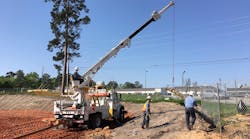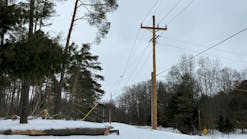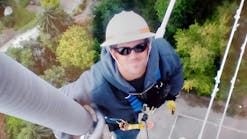New Digger Derrick Standard Includes Provisions for Operators and Owners
The ANSI/ASSP A10.31-2019 standard for digger derricks became effective June 1, 2020, and includes new requirements for owners, users, operators, lessors and lessees, as well as brokers of the equipment. Several of the new requirements relate to training, inspection and operation.
Regardless of your role, Terex Utilities encourages anyone with responsibility for the installation or remount, inspection and maintenance, training of operators and equipment selection and operation to obtain a copy of the 2019 standard to determine if their work practices are affected. This article highlights a few of the new responsibilities and reinforces some existing requirements.
Maintenance Training and Documentation
Anyone conducting maintenance on the equipment, regardless of who they are employed by, must be trained on proper inspection, maintenance and testing of the equipment. Likewise, inspections and tests must be conducted by a qualified person and inspection and test records documented and retained. The daily pre-shift inspection does not need to be documented unless a safety hazard issue is found, then a record of the issue and correction must be retained for five years. Periodic inspections and tests records must be retained for five years. When a periodic dielectric testing is conducted, the record of test must be provided and retained by the owner and a placard showing proof of test date must be displayed on the equipment.
Operator Training and Documentation
Operator training must be documented with proof of training and indicate how long that training is valid. Training documentation must be retained by the entity that conducted the training for as long as the training is valid. The employee must demonstrate proficiency to the employer before they can be considered as completing training. Training on the operation of the digger derrick does not mean the operator is properly trained for the tasks assigned by his employer without further training specific to the tasks assigned.
Retraining requirements for operators have also been expanded to mirror language in the A92.2 standard for aerial devices. Two situations are noted for when retraining is needed: 1) if the user/owner observes that the operator needs retraining, and 2) if the operator has an accident or near miss. The responsibility for making sure that the operator or users is trained falls to that individual’s employer.
Ingress/Egress and Installation
Language that comes from the A92.2 aerial device standard now provides more direction on design and installation of steps, ladders, and whether three points of contact are needed. Although open to interpretation, this is important information as it relates to access from the ground to the truck and from the deck to the control station. These access systems must be maintained.
The standard identifies specific parameters for height of steps, distance between steps, the width of rungs, minimum height and width of passage openings, and so forth. Any entity involved in installation will want to be familiar with this language. Installers and users should be aware that the addition of any device, or modifications, can only be done with written approval of the manufacturer. Modification includes things such as platforms, jibs, winches, or other auxiliary devices. Alterations or removal of safety devices is never allowed.
Platforms are not permitted to be used on a digger derrick unless approved by the manufacturer and the unit is properly equipped and tested for such use. Related to this, all testing, regardless of who it is performed by, must follow the manufacturer’s guidelines for doing so. Use of a platform, without platform controls, on energized structures is prohibited.
Operation
New language intended to prevent unauthorized use delegates responsibility to all entities to ensure the machine is secured when not in use. Overriding safety devices is prohibited for normal operation. It is allowed for rescue operation and maintenance only following instruction for the procedure provided by the manufacturer.
A couple of other operational changes worth noting relate to using a digger derrick with a platform. If working in an approved platform or bucket, new language now indicates it is only allowed for the operator to exit or enter the from an elevated position if it is not prohibited by the manufacturer, and the activity must be done in accordance with ANSI/IEEE and OSHA requirements. Loads, including materials and personnel, can only be added to the platform at height within these requirements.
When carrying material in the platform, guidance is provided for securing the load, dispersing the weight, and being within the capacity of the individual to handle, again, if it is within manufacturer’s limitations on the platform capacity.
One final note on operation outside the scope of the ANSI standard. OSHA may require digger derrick operators to be certified, depending on the work being performed. Operators of digger derricks are exempt from this requirement only when the digger derrick is performing electric power generation, transmission, and distribution, and telecommunications tasks. If a digger derrick is used for other lifting work considered by OSHA as being construction, then digger derrick operators must be certified as a digger derrick operatory by a nationally recognized certifying organization.
Design changes affecting operation
The A10-31-2019 standard also addresses new design requirements for manufacturers. Equipment manufactured after June 1, 2020 need to integrate these provisions, which also may affect the way equipment operates and is used. Terex Utilities has previously included several of these designs as standard features.
- Boom controls and outrigger controls cannot operate at the same time.
- The stability test remains the same—85% for lifting with the vehicle level. Plus, ANSI A92.2 requirements for platform use both level and on a 5-degree slope with the truck bed at 5 degrees, not corrected with the outriggers.
- Slope indicators must be provided in a visible location for setting up the unit.
- Outriggers must be interlocked to prevent boom operation until the outriggers have been extended.
- The parking brake must be set for the boom to be operational.
- Boom overload limiters are required for boom lower, extend, winch up, and digger dig functions. Note that HOP is not to be used to determine lifting capacity.
- Rotation load protection system is required to prevent excessive rotational loading.
- Vacuum protection is no longer required for units over 50 ft.


